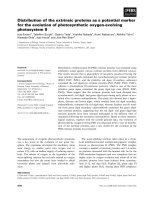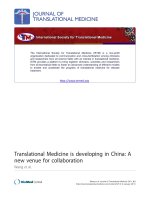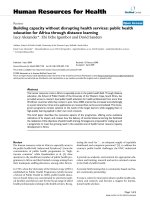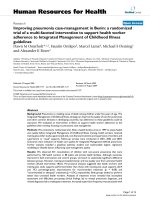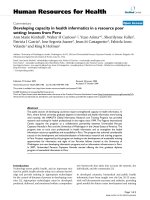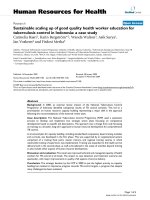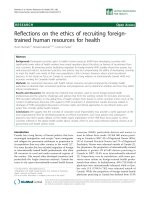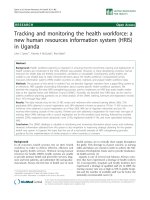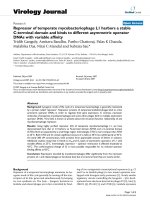Báo cáo sinh học: " Buffy coat specimens remain viable as a DNA source for highly multiplexed genome-wide genetic tests after long term storage" pptx
Bạn đang xem bản rút gọn của tài liệu. Xem và tải ngay bản đầy đủ của tài liệu tại đây (441.7 KB, 8 trang )
RESEARCH Open Access
Buffy coat specimens remain viable as a DNA
source for highly multiplexed genome-wide
genetic tests after long term storage
Josyf C Mychaleckyj
1*
, Emily A Farber
1
, Jessica Chmielewski
2
, Jamie Artale
1
, Laney S Light
3
, Donald W Bowden
4
,
Xuanlin Hou
1
and Santica M Marcovina
2
Abstract
Background: Blood specimen collection at an early study visit is often included in observational studies or clinical
trials for analysis of secondary outcome biomarkers. A common protocol is to store buffy coat specimens for future
DNA isolation and these may remain in frozen storage for many years. It is uncertain if the DNA remains suitable
for modern genome wide association (GWA) genotyping.
Methods: We isolated DNA from 120 Action to Control Cardiovascular Risk in Diabetes (ACCORD) clinical trial buffy
coats sampling a range of storage times up to 9 years and other factors that could influence DNA yield. We performed
TaqMan SNP and GWA genotyping to test whether the DNA retained integrity for high quality genetic analysis.
Results: We tested two QIAGEN automated protocols for DNA isolation, preferring the Compromised Blood
Protocol despite similar yields. We isolated DNA from all 120 specimens (yield range 1.1-312 ug per 8.5 ml ACD
tube of whole blood) with only 3/120 samples yielding < 10 ug DNA. Age of participant at blood draw was
negatively associated with yield (mean change -2.1 ug/year). DNA quality was very good based on gel
electrophoresis QC, TaqMan genotyping of 6 SNPs (genotyping no-call rate 1.1% in 702 genotypes), and excellent
quality GWA genotyping data (maximum per sample genotype missing rate 0.64%).
Conclusions: When collected as a long term clinical trial or biobank specimen for DNA, buffy coats can be stored
for up to 9 years in a -80degC frozen state and still produce high yields of DNA suitable for GWA analysis and
other genetic testing.
Trial Registration: The Action to Control Cardiovascular Risk in Diabetes (ACCORD) trial is registered with
ClinicalTrials.gov, number NCT00000620.
Background
Clinical trials and prospective observational cohort stu-
dies are complex to design and costly to implement,
hence there is a strong desire to maximize overall clini-
cal and scientific return on investment. A common
strategy is to include blood specimen collection at a
baseline or early participant study visit to enable future
ancillary studies or analysis of secondary biomarker ou t-
comes. The blood specimens may be processed to pro-
duce aliquots of sera, plasma, or blood cell pack that are
stored frozen for future use. For genetics studies, DNA
is more stable under long-term freezer storage, but in
many existing or completed studies, the study protocol
required the extraction and storage of buffy coats (ali-
quots of white blood cell pack) [1,2]. The Action to
Control Cardiovascular Risk in Diabetes (ACCORD)
clinical trial is o ne such study that banked buffy coat
specimens for future use in genetic ancillary studies.
Several studies have demonstrated a decre ased DNA
yield with frozen storage over time [3-5].
The ACCORD trial was a randomized, multicenter,
double 2 × 2 factorial design which recruited 10,251
type 2 diabetes patients that were randomized to glyce-
mic interventions, of which 5,518 were randomized to
* Correspondence:
1
Center for Public Health Genomics, University of Virginia, Charlottesville, VA,
USA
Full list of author information is available at the end of the article
Mychaleckyj et al. Journal of Translational Medicine 2011, 9:91
/>© 2011 Mychaleckyj et al; licensee BioMed Central Ltd. This is an Open Access article distributed under the terms of the Creative
Commons Attri bution License ( which permits unrestricted use, distribution, and
reproduction in any medium, provided the original work is properly cited.
lipid interventions in one 2 × 2 trial and 4,733 rando-
mized to blood pressure interventions in the second 2 ×
2 trial [6,7]. The trial was designed to test the effects on
major cardiovascular disease events of intensive glyce-
mia control, treatme nt to increase HDL-cholesterol and
lower triglycerides, and intensive blood pressure cont rol
(in the context of good glycemia and LDL control).
Recruitment occurred in two phase s, January - June
2001 (Vanguard Phase, N = 1,174), and February 2003-
October 2005 (N = 9,077) [8]. Participants were
recruited, randomized, treated, and followed t hrough a
system of seven Clinical Center Networks (CCNs). Each
CCN consisted of a network of collaborating clinical
sites.
The trial protocol required clinics to collect a single 8.5
ml Acid Citrate Dextrose (ACD) tube of whole blood from
trial participants who consented to the use of a blood spe-
cimen for future genetics studies. The specimens were
refrigerated, shipped, and processed to yield buffy coats,
which were stored frozen at -80 degC. These specimens
have been in storage for variable periods of time, and up
to 9 years for the trial Vanguard phase participants. It was
unclear whether they had degraded significantly and were
no longer viable for modern highly multiplexed GWA
genotyping assays that simultaneously genotype 1 million
SNPs and CNV probes (or more). We designed this study
to answer two specific questions:
1. What was the total yield of DNA that could be
expected from the buffy coat specimens collected
and stored under the ACCORD trial protocol?
2. Was the isolated DNA still of sufficient quali ty to
provide a substrate for multiplex GWA genotyping?
We isolated the DNA from 120 ACCORD trial buffy
coat specimens selected from all 8 sub-arms of the trial
to sample a range of storage times and other study fac-
tors that could predict total DNA yield. We performed
individual SNP genoty ping on aliquots from all 120 spe-
cimens and a GWA genotyping assay on 32 of the 120
to test whether the isolated DNA has retained molecular
integrity for high-quality GWA study analysis.
Methods
Buffy Coat Specimen Collection and Storage
One 8.5 ml ACD tube of whole blood was c ollected
from ACCORD participants during their baseline trial
visit and refrigerated at 4 degC at the recruitment clinic
unti l shipment. Institutional Review Board approval was
obtained from all recruitment, laboratory, or data man-
agement sites and written informed consent was
obtained from study subjects. The shipping protocol
required the clinics to ship the blood tube on cold pack
refrigerant to the ACCORD Centra l Laboratory on the
same day as collection by overnight courier (within 24
hours). All buffy coats, without exception, were
extracted on the day of receipt at the Central Labora-
tory. Processing and stora ge of the buffy coat fraction
(white blood cell layer) was performed following the
recommendations of the NHLBI Working Group [1].
Briefly, the ACD tube was centrifuged at 2000 rpm for
30 mins and the plasma removed. Using a sterile trans-
fer pipette, the buffy coat layer was transferred to a ster-
ile barcoded cryovial and placed on ice. An equal
volume of cell freezing solution (99% glycerol, 50 nM
sodium citrate, 20 mM sodium phosphate m onobasic,
monohydrate, and 20 mM sodium phosphate, dibasic,
anhydrous) was added and the cells suspended by gentle
rocking. The cryovial containing the cells was immedi-
ately transferred to a -80 degC REVCO Ultima freezer
(Thermo Fisher Scientific Inc., Waltham, MA) with
audible/visual warning for power failure and tempera-
ture deviati on beyond set points. The freezer was moni-
tored by a 24 hr alarm m onitoring company, with
mont hly testing for alarm system operation. The freezer
was connected to a 100 KW on site backup generator
with automatic failover in case of a power outage.
Prior to DNA isolation, 120 stored frozen buffy coat
specimens were randomly selected by the ACCORD
Coordinating Center out of 6,008 participants who had
consented to the broadest categories of genetics study
usage of their specimen. The specimens were sampled
with even distribution across a range of blood sample
storage duration and trial assignment. There were fewer
specimens available for selection in the period 2006-2009
than from earlier years (none were drawn in 2002). An
equa l number of specimens were selected from each of 5
time periods (2001, 2003, 2004, 2005, and 2006-2009) to
sample a range of storage durations. No more than 3 par-
ticipants were selected per clinic site. The specimen char-
acteristics are shown in Table 1. The 120 sampled
individuals are representative of the overall trial pool:
35% female (39% trial); 64% white (62% trial); 19% Afri-
can American (19% trial); mean age at draw 63.5 years
(62.2 years trial).
DNA Isolation Protocol
Frozen buffy coat specimens were shipped to Universit y
of Virginia Ce nter for Public Health Genomics for DNA
isolation and GWA genotyping. DNA was isolated using
automated purification protocols on a QIAGEN
®
Autopure LS
®
. Two initial test runs of 8 samples each
were performed to compare candidate isolation proto-
cols:
1. QIAGEN
®
Automated purification of DNA from
fresh or frozen buffy coat on the Autopure LS
®
(protocol version AP03 Nov-07, up to 10 ml sample)
Mychaleckyj et al. Journal of Translational Medicine 2011, 9:91
/>Page 2 of 8
2. QIAGEN
®
Automated purification of DNA from
compromised blood samples on the Autopure LS
®
(protocol version AP06 Nov-07, up to 10 ml
sample).
(Protocol documents are available at -
gen.com). According to the vendor description, protocol
1. for fresh or frozen buffy coats is applicable for sam-
ples frozen at -80 degC directly after collection and
stored for less than 2 years at this temperature. The
main differences between the protocols are that the
compromised blood protocol 2 dispenses additional
RBC lysis reagent (40 ml versus 35 ml total volume) and
incubates for 30 seconds longer during lysis; uses 4 ml
protein precipitation solution versus 3.34 ml during
WBC lysis/protein precipitation step and centrifuges at
3000 g for 5 min versus 2 mins; centrifuges for 5 mins
versus 2 mins at 3000 g during initial DNA precipitation
step; and during DNA wash, uses 12 ml 70% ethanol
ver sus 10 ml, and centrifuges for 5 min versus 1 min at
3000 g after alcohol wash to re-precipitate the DNA.
Since t he results from the compromised blood protocol
2 were superior, the compromised blood protocol was
used for the remain ing 104 samples. The remaini ng
samples were processed in runs of 16 samples at a time.
DNA Quality Control
After isolation and purification, the DNA was quantitated
on a NanoDrop 8000, to measure concentration and assess
the purity of the DNA thr ough standard A260/A280 and
A260/A230 ratios. The DNA was diluted to 400 ul total,
except where yields were lower. A 3 ul aliquot of the DNA
solution was evaluated for DNA length distribution and
potential degradatio n by electrophoresis on a 1% agarose
gel agains t a molecular weight ladder with ethidium bro-
mide staining.
SNP Genotyping QC
One hundred and seventeen DNA specimens were tested
for success in genotyping individual SNPs using Applied
Biosystems TaqMan
®
assays. Three (3/120) samples were
not genotyped due to low total DNA yield (1.07 ug, 4.00
ug, 5.22 ug) and the need to preserve the DNA for future
disease genetics studies. The TaqMan genotyping assay is
a QC test of the suitability of the isolated DNA for single
SNP genotyping. Failure in this step indicates that the
DNA quality is unlikely to be sufficient for highly multi-
plexed GWA genotyping. A limited panel of 6 high het-
erozygosity autosomal SNPs located on different human
chromosomes was selected for this purpose. Applied Bio-
systems TaqMan
®
Genotyping Assay Protocol (Part
Number 4332856 Rev. C 05/2006) was used to genotype
the SNPs on an Applied Biosystems 7900HT Fast Real-
Time PCR System using standard reagents and standard
cycling protocols. The SNPs are listed in Table 2.
GWA Genotyping Assay
Thirt y two spec imens were randomly pre-selected by the
ACCORD Coordinating Center for GWA genotyping
before DNA isolation results were available. After DNA
isolation 5 of these were found to have total DNA yield <
50 ug. To conserve these for future analysis, we substi-
tuted 5 higher yield specimens (yield > 50 ug) that
matched the substituted specimen characteristics as far as
poss ible with respect to year, gender, race (4/5 matches),
and recruiting CCN. The 32 samples were genotyped on 8
Illumina Human Omni1-Quad beadchips, each beadchip
assaying four samples for 1,140,419 SNPs and CNV
probes. A minimum of 200 ng of DNA is required per
Table 1 Clinical characteristics of the stored buffy coat
samples selected for DNA isolation, N = 120 total
samples
Buffy Coat Sample Characteristic N (% or Std Err)
Gender:
Male 78 (65%)
Female 42 (35%)
Race:
White 77 (64.2%)
African-American 23 (19.2%)
Hispanic 7 (5.8%)
Asian 5 (4.2%)
Other 8 (6.7%)
Age at Draw:
Mean years (Std Err) 63.5 (0.66)
Range years 43-80
Year Drawn:
2001 24 (20%)
2003 24 (20%)
2004 24 (20%)
2005 24 (20%)
2006 11 (9.2%)
2007 10 (8.3%)
2008 3 (2.5%)
Recruiting Clinical Center Network (CCN):
Total CCNs Sampled 7
Mean Samples per CCN (Range) 17.1 (9-20)
Recruiting Clinic:
Total Clinics Sampled 74
Mean Samples per Clinic (Range) 1.62 (1-3)
Laboratory Receipt Time:
Mean hours (Std Err) 29.3 (1.52)
Range hours 12-144
Percentage sums may differ from 100% due to rounding. The Laboratory
Receipt Time is the time in hours from blood collection to receipt in the
Central Laboratory. The value in the parentheses after the count value in the
column labeled N is the percentage or standard error except where noted as
a range.
Mychaleckyj et al. Journal of Translational Medicine 2011, 9:91
/>Page 3 of 8
sample />datasheets/datasheet_humanomni1_quad.pdf. The geno-
typing assay was performed according to the standard Illu-
mina Infinium HD Super Assay protocol (Infinium HD
Super Assay P rotocol Guide, Catalog #WG-901-4002
Part# 11322427 Rev.B).
GWA Genotyping Assay QC
The quality of the GWA genotyping data was assessed
using the vendor built-in positive and negative quality
control steps in the Illumina GenomeStudio software
suite. Seven GWA genotyping assay controls included
with every Illumina Infinium HD array monitor amplifi-
cation, hybridization, extension, stripping, and staining
which are assessed using the GenCall dashboard [9].
These were visually inspected for all sample GWA assays
/>ware.ilmn. The Gentrain2 algorithm was used for SNP
quality sco ring and the genotypes were also curated
according to standard vendor genotyping QC protocol.
Since only 32 samples were clustered, the standard clus-
ter file (HumanOmni1-Quad_v1-0_B.egt) was used as per
vendor recommendations for projects with less than 100
samples (Illumina Technote “Inf inium Genotyping Data
Analysis” />ducts/technotes/technote_infinium_genotyping_data_a-
nalysis.pdf. SNP curation was performed following
recommendations in the same document. This protocol
identifies SNPs that should be manually reviewed by an
experienced technic ian. All genotypes for poorly per-
forming SNPs were set to missing. A separate cluster
analysis was performed for X chromosome SNPs.
GWA Statistical Genotype QC Analysis
After the genotyping laboratory QC was complete, data
was exported from Illumina GenomeStudio for addi-
tional QC and statistical analysis. This QC mirrored the
standard steps used for genotype data QC in many
GWA studies to control the type 1 er ror rate associated
with mult iple testing of many thousands of SNPs
[10,11]. The statistics included genotype missing rates
by sample and by SNP.
Results
Isolated DNA Yields
We were able to isolate DNA from all 120 buffy coat spe-
cimens, with varying total yield. Since the buffy coat spe-
cimens had been in storage for range of durations up to 9
years, we tested two automated DNA purification proto-
cols on a QIAGEN Autopure LS, 1) fresh or frozen buffy
coat and 2) compromised blood sample. We compared
the two protocols by comparing the yield and assay per-
formance on a randomly selected subset of 8 samples for
each protocol. We found no significant difference in the
mean yield between the first subset, isolated using the
buffy coat protocol, and second compromised blood pro-
tocol subset, mean yield (+/-sem) 139.3 +/- 9.0 ug and
162.5 +/- 9.8 ug respectively (Welch t-test p = 0.55); or
between the first 8 and the remaining 112 isolated using
the Compromised Blood Protocol, mean yield 139.3
+/-9.0 ug and 134.4 +/-0.6 ug (p = 0.86). However the
Buffy Coat protocol group of 8 samples appeared to con-
tain protein contamination after purification, did not
rehydrate well, and had to be re-purified manually. The
second group showed clean pellets and dissolved into
solution without difficulty, hence we chose this protocol
for automated purification of the rest of the samples.
The distribution of total yield from all 120 samples is
shown in Figure 1. For the 112 Compromised Blood Pro-
tocol specimens, the range of yields was 1.1-312.2 ug.
Thirteen samples (11.6%) yielded < 50 ug, while 3 samples
(2.67%) produced a yield of < 10 ug of DNA. For all 120
samples including the 8 isolated by Buffy Coat protocol,
14 yielded total DNA < 50 ug (11.7%), 4 samples yielded <
10 ug (3.3%), and 111 (92.5%) had sufficient yield to dilute
into 400 ul total for future DNA stock solution (minimum
required concentration 100 ng/ul). The lowest yield sam-
ples were diluted into 50 ul total stock to allow for multi-
ple future aliquots but with variable lower concentrations.
The mean yield for all 120 samples was 134.7 ug +/-0.6 ug
and median was 130.6 ug.
To investigate the effect of study or participant factors
on the yield, we tested linear regression models of total
DNA yield. Figure 2 shows the yield for the different
years of collection. We dropped 3 samples collected in
Table 2 SNP panel composition and genotyping results
dbSNP rs number) ABI TaqMan Assay Identifier Genome Location Samples Genotyped Missing Genotypes (%)
rs7792547 c_29193799_10 Chr7: 150754462 117 4 (3.4%)
rs7326634 c_306605_10 Chr13: 85638600 117 1 (0.85%)
rs1293288 C_8339785_10 Chr8: 11755937 117 0 (0%)
rs6935566 c_29104855_10 Chr6: 149608518 117 1 (0.85%)
rs2251110 c_8793799_20 Chr15: 31385829 117 0 (0%)
rs2118922 c_15975275_10 Chr4: 178404068 117 2 (1.7%)
The table lists the dbSNP rs number, ABI identifier, genome location, number of samples assayed, and the missing genotype count and proportion for the 6SNPs
assayed by TaqMan genotyping. (ABI or Applied Biosystems Inc, is now part of Life Technologies).
Mychaleckyj et al. Journal of Translational Medicine 2011, 9:91
/>Page 4 of 8
2008 because of insufficient cases, and recoded Asian (N
= 5) and Hispanic (N = 7) samples as race “ Other ”,ie
non-White or African-American, giving White = 75,
African-American = 22, Other = 20 (N = 5 Asian + 7
Hispanic + 8 coded Other in trial). Results for multivari-
ate analysis of total DNA yield are shown in Table 3.
There was no margin al association of yield with race (p
= 0.16), gender (p = 0.3), clinical center network (p =
0.28), or lab r eceipt time (p = 0.16) after adjustment for
other factors. However in the same model, year of blood
collection was negatively associated with yield (beta =
-11.6 ug per year +/- 4.2, p = 0.009), and age at collec-
tion was also negatively associated (beta = -2.1 ug per
year +/- 0.8, p = 0.015). After dropping the 2001 speci-
mens, year of collection was no longer significant (beta
= -0.7+/- 8.3 ug, p = 0.9). Collectively these factors
explain 23.5% of the total yield variance (F
12,104
= 2.66,
p = 0.004). We discuss the surprising dependency of
total yield on year of collection below.
DNA Quality Control
The isolated DNA was also assessed for other factors
indicative of DNA quality. The NanoDrop measured
A260/A260 ratio s for the 120 samples were found to be
in the range 1.76-2.88, mean 1.86 and median 1.84.
Three samples had ratios greater than 1.9 (2.63, 2.88,
2.05), and.all 3 of these samples also had total DNA
yields < 10 ug. The results of the DNA fragmentation
analysis using agarose gel electrophoresis produced dis-
tinct, bright, homogeneous bands of high molecular
weight qualitatively indicating DNA that was non-
degraded, free of smearing caused by presence of low
molecular weight RNA, and of good quality (data not
shown).
SNP Genotyping QC
We genotyped 117 specim ens in 6 SNP TaqMan assays.
There were 8 total missing genotypes giving an overall
missing genotype rate of 8/(117 × 6) or 1.1%. The maxi-
mum missing genotype rate per specimen was 2/6 geno-
types (33%). This sample had a total yield of 109.8 ug
and therefore the higher missing rate does not appear to
be coincident with a low total yield. Table 4 summarizes
the genotyping results for each SNP. The maximum
missing rate per SNP was 3.4% (4/117) although this
rate per SNP is not higher than expected for an overall
per genotype missing rate of 1.1% (1-sided binomial test
p = 0.01, multiple testing corrected alpha = 0.05/6 SNPs
= 0.0083). We did not repeat the failed genotypes.
GWA Genotyping Assay QC
The assays for all 32 samples were assessed according to
the 7 genotyping assay controls included with every Illu-
mina Infini um HD array to monitor am plification,
hybridization, extension, stri pping, and staining. There
were no ob vious poorly performing samples out of the
32 total for any of control measures. Manual curation of
GWA genotype data by an experienced laborat ory man-
ager using standard Illumina GenomeStudio software
and protocols iden tified 1,186 SNPS that passed initial
automated software QC but showed overlapping or
Figure 1 Distribution of total DNA yield from 120 ACCORD
buffy coat specimens. The histogram shows the number of
samples within each interval of total DNA yield. The interval size is
25 ug, and the maximum and minimum yields were 1.1 ug and
312.2 ug.
Figure 2 Total DNA yield as a fun ction of col lection year from
120 ACCORD buffy coat specimens. The figure shows a Tukey
boxplot of variation in DNA yield for each year of blood collection
in the 120 ACCORD samples. The upper and lower edges (hinges)
of the boxes are the third and first quartiles and the central line
shows the median value of yield for a year. The lines radiating
above and below the boxes visually show the range to the
maximum and minimum yields. There are no outlier samples in any
of the years with unusually large or small yields as defined by the
usual robust test of more than 1.5 × interquartile range.
Mychaleckyj et al. Journal of Translational Medicine 2011, 9:91
/>Page 5 of 8
indisti nct genot ype clust er separation that coul d lead to
significant errors in genotype assignment and inflated
type 1 error rate in a GWA study. The genotypes for
these SNPs were set to missing and would not be ana-
lyzed in the statistical tests of association of phenotype
and genotypes in a GWA study.
GWA Statistical Genotype QC
The results of the GWA statistical genotype QC analysis
are summarized in Table 3. The results for the 32 speci-
mens are extremely good with a mean per sample geno-
type missing rate of 0.21%, (99.79% genotype calling
rate), and a maximum sample genotype missing rate of
0.64%, (99.36% calling rate). Applying a standard thresh-
old of 95% genotype calling rate for statistical genotype
QC analysis would result in none of the 32 samples
being dropped after these initial steps. The per SNP
missing rates are also comparable with standard results
with mean and median missing genotype rates of 0.21%
and 0% respectively although the accuracy of the SNP
clustering is compromised by availability of only 32
study samples. There were 10,036 SNPs with a missing
rate > = 6.25% (> = 2/32 genotypes missing per SNP)
and 49,574 SNPs with a missing rate > = 3.125% (> = 1/
32 genotypes missing per SNP).
Discussion
This study was initiated to answer questions about the
expected total yield and suitability for GWA analysis of
DNA isolated from buffy coat specimens that had been
Table 3 Combined linear regression and analysis of variance results for predictor variables of the total DNA yield (ug)
Predictor Number of Observations Effect Size (Std Err) t-test p-value anova df anova p-value
Race (AfrAm) 22 2 0.16
White 75 -7.4 ug (15.8) 0.21
Other 20 25.7 ug (20.6) 0.64
Year 117 -11.6 ug (4.2) 0.0061 1 0.0061
CCN 117 6 0.28
Gender (Female) 42 0.30
Male 75 13.8 ug (13.1) 0.30 1
Age 117 -2.1 ug/year (0.84) 0.015 1 0.015
Lab Receipt Time 117 -0.7 ug/hour (0.5) 0.16 1 0.16
The table contains the marginal univariate t-test results are shown for all predictor variables with 1 or 2 degrees of freedom (df). The marginal tests describe the
effect of the predictor variable after adjusting for all other variables in the model. The individual t-test results for each CCN are not shown. The anova and t-test
p-values are necessarily identical for 1 degree of freedom predictors. The reference category for the categorical predictor variables (Race and Gender) are shown
in parentheses beside the variable name.
Table 4 ACCORD Illumina Omni1-Quad Statistical Genotype QC Analysis Results
Step Samples Remaining SNPs Remaining Dropped (% of Remaining)
Post-Laboratory QC 32 1,140,419
(inc CNV probes)
Remove CNV probes
(not analyzed)
1,048,713 91,706
Drop SNPs with 100% missing data 32 1,015,235 33,478
(3.3%)
Drop samples with > 1% missing data 32 1,015,235 0
(0%)
Total 32 1,015,235
QC Statistic N Value Comments
Mean per sample Genotype Missing Rate (range; sem) 32 0.20%
(0.07-0.62%; 0.024%)
For all SNPs
0.21%
(0.07-0.64%; 0.025%)
SNPs with < 100% missing genotypes
Median per sample Genotype Missing Rate 32 0.16%
Mean per SNP Genotype Missing Rate
(range; sem)
1,015,235 0.21%
(0-37.5%; 0.0012%)
32 Samples
Median per SNP Genotype Missing Rate 1,015,235 0% 32 Samples
The upper part of the table shows the samples and SNPs that were dropped at each step of the Statistical Genotype QC analysis and the total number
remaining. The lower part of the table summarizes values of the key QC statistics in the samples and SNPs remaining after the QC steps.
Mychaleckyj et al. Journal of Translational Medicine 2011, 9:91
/>Page 6 of 8
in long term frozen storage for up to 9 years. The buffy
coat specimens were collected under the ACCORD trial
protocol, from a single participant ACD tube of blood
that was drawn, refrigerated, shipped to the ACCORD
Central Laboratory on the day of collection, and pro-
cessed into buffy coats the same day as receipt for long
term storage at -80degC. Our concern was the effect of
long term storage on total yield and fragmentation of
DNA resulting from the denaturation of accompanying
blood proteins, or DNA degradation by enzymes
released through cell lysis.
We tested two QIAGEN automated protocols for
DNA isolation and established a preference for the com-
promised blood protocol based on apparently lower
contamination of the DNA pellets and ease of rehydra-
tion, although the yields were similar from this protocol
and the buffy coat protocol. The main differences
between the protocols are that the compromised blood
dispenses greater volumes of reagents for red blood cell
lysis,, protein and DNA precipitation and centrifuges for
longer during initial DNA pelleting, precipitation and
after DNA wash steps. Presumably the increased reagent
volumes, particularly the Autopure Precipitation Solu-
tion, and the incr eased centrifugation time account for
the lower protein contamination and ease of DNA
solution.
We isolated DNA from all 120 buffy coats specimens
with variable yiel ds up to a maximum of 312 u g per 8.5
ml ACD tube of whole blood. Only 4 specimens (3.3%)
yielded < 10 ug of DNA and 3 of these had 260/280
ratios > 1.9. These 3 samples also had the lowest con-
centration after the DNA stock dilu tion procedure (<
21.4 ng/ul) while the 4th had concentration 73.6 ng/ul.
The extreme 260/280 ratios may result from low stock
concentrations, despite the fact that stated lower limit
for the NanoDrop 8000 is 2.5 ng/ul (NanoDrop 8000
Spectrophotometer V2.2 User’sManual,ThermoScien-
tific Inc), or may reflect the presence of other contami-
nants that are associated with low yield. Since modern
GWA assay protocols require < 1 ug total per sample
we expect ample yield from the majority of the samples
in storage for GWA studies. Other genetic assays such
as next generation exome resequencing using solution-
based capture require approx 4-5 ug per sample, but
even these more demanding assays should be possible
for the majority of samples based on the buffy coat yield
distribution.
We found no association of sample race, gender, or
regional clinical center network with total DNA yield. We
also found no significant association with lab receipt time
(range 12-144 hours). We found a dependency on the age
of study participant at time of blood draw (-2.1 ug total
yield per year of age), which compares with a similar asso-
ciation of approx -5 u g per year of age seen for DNA
yiel ds from whole blood samples stored at 4 degC for up
to 2.5 years [12]. This decline in yield with age may be
caused by a decrease in total leukocyte and lymphocyte
count, accompanying a progressive decline in immune
function. Erkeller-Yuksel et al found a statistically signifi-
cant halving in leukocyte count from birth (cord blood) to
adults in the 18-year to 70-year age group [13], and studies
of reference ranges for lymphocyte subsets have also
shown a decline with age [14]. The ACCORD study cohort
is comprised of type 2 diabetic patients with comorbidities
that could include inflammatory processes, atherosclerosis,
and other diabetic complications. Paradoxically, we found
that yield significantly increased for the oldest specimens
drawn in 2001 after 9 years of storage. It is possible that
the 120 test buffy coats may be confounded for year of col-
lection by other clinical factors that could explain the
negative dependency of yield on year. The 2001 specimens
were from the trial Vanguard phase, and these participants
had some clinical differences from those in the main trial
phase [8]. In particular they were lighter by 5.6 lbs, and a
lower proportion were current smokers (11.4% vs 14.3%).
Most intriguing is that there was a big difference in statin
use, 45.5% Vanguard vs 61.1% main trial. Pravastatin has
recently been shown to decrease the peripheral blood leu-
kocyte count over a six month period in patients with cor-
onary artery disease [15].
For comparison with a recent large study using fresh
blood isolation, the international Type 1 Diabetes Genet-
ics Consortium reported that mean total yield of DNA
from 14,022 samples of cell pack isolated from 5 ml
EDTA tubes of whole blood shipped refrigerated was 144
ug (range 92-165 ug) by salting out or chloroform extrac-
tion procedure [16]. The mean yield was 28.8 ug/ml com-
pared to the present study of 15.8 ug/ml, for a 45% loss of
yield in comparing the EDTA collected fresh refrigerated
blood DNA is olation with that obtained from frozen
buffy coat extracted from ACD tubes.
TheDNAqualityappearedtobeverygoodbasedon
several QC indices including standard agarose gel elec-
trophoresis and TaqMan genotyping of a 6 SNP panel in
117 DNA samples, for a genotyping no-call rate of 1.1%
in 702 total genotypes. The missing genotypes were not
significantly clustered by SNP or specimen and probably
represent instances where desiccation occurred during
the PCR reaction for specimens in plate edge wells,
hence no unambiguous genotype was registered due to
low well sample volume.
The ultimate QC test was whether the samples gener-
ated useful GWA genotype profiles for the 32 samples.
The resulting DNA produced excellent quality GWA gen-
otyping data as measured by standard post-genotyping sta-
tistics. The maximum per sample genotype missing rate
was 0.64%. Applying a standard threshold of 95% genotype
calling rate for GWA statistical genotype QC analysis
Mychaleckyj et al. Journal of Translational Medicine 2011, 9:91
/>Page 7 of 8
would result in none of the 32 samples being dropped
after these initial steps. The SNP missing rates are also
compa rable with standard results with mean and median
missing genotype rates of 0.21% and 0% respectively. We
substituted 5 of the pre-selected 32 samples for GWA gen-
otyping that had lower total DNA yield (< 50 ug) for
higher yield sam ples a nd this may have bi ased the GWA
results and the assessment of overall success rate com-
pared to initial random selection, but this step was purely
to preserve stock DNA for future disease genetics studies
since the DNA in the samples with yield > 10 ug and < 50
ug appeared to have a similar molecular weight profile and
integrity compared to the high yiel d samples. The 4 sam-
ples (3.3% of 120 total) with < 10 ug yield had extreme
260/280 ratios (> 2.0) which might suggest possible future
problems with genome wide genotyping assays.
Conclusions
The results of this pilot study demonstrate that buffy coats
can be used as a long term clinical trial or biobank speci-
men for DNA, in lieu of immediately isolating the DNA at
collection. We have shown that it can be stored for stored
for up to nine years in a -80degC frozen state, yet still pro-
duce high yields of DNA that is suitable for GWA analysis
and other genetic testing using single SNP genotyping
methods.
Abbreviations
ACCORD: Action to Control Cardiovascular Risk in Diabetes; ACD: Acid Citrate
Dextrose; CCN: Clinical Center Network; CNV: Copy Number Variant; dsDNA:
double-stranded DNA; GWA: Genome Wide Association; NHLBI: National
Heart Lung and Blood Institute; PCR: Polymerase Chain Reaction; QC: Quality
Control; SNP: Single Nucleotide Polymorphism
Acknowledgements
The ACCORD Trial was supported by grants (N01-HC-95178, N01-HC-95179,
N01-HC-95180, N01-HC-95181, N01-HC-95182, N01-HC-95183, N01-HC-95184,
IAA-Y1-HC-9035, and IAA-Y1-HC-1010) from the National Heart, Lung, and
Blood Institute; by the National Institute of Diabetes and Digestive and
Kidney Diseases, the National Institute on Aging, and the National Eye
Institute; by the Centers for Disease Control and Prevention; and by General
Clinical Research Centers. Abbott Laboratories, Amylin Pharmaceutical,
AstraZeneca Pharmaceuticals LP, Bayer HealthCare LLC, Closer Healthcare,
GlaxoSmithKline Pharmaceuticals, King Pharmaceuticals, Merck, Novartis
Pharmaceuticals, Novo Nordisk, Omron Healthcare, Sanofi-Aventis US, and
Takeda Pharmaceuticals provided study medications, equipment, or supplies.
ACCORD is registered with ClinicalTrials.gov, number NCT00000620.
Author details
1
Center for Public Health Genomics, University of Virginia, Charlottesville, VA,
USA.
2
Northwest Lipid Metabolism and Diabetes Research Laboratories,
University of Washington, Seattle, WA, USA.
3
Division of Public Health
Sciences, Wake Forest University School of Medicine, Winston-Salem, NC,
USA.
4
Center for Diabetes Research, Wake Forest University School of
Medicine, Winston-Salem, NC, USA.
Authors’ contributions
JCM conceived of the study, participated in its design and coordination and
wrote the main draft of the manuscript. EAF performed laboratory genetic
assays. JC performed buffy coat laboratory processing and coordinated study
specimen repository. JA isolated and performed quality control on DNA. LSL
participated in the design of the study and performed data analysis. DWB
advised the study on genetic analysis methods and edited the manuscript.
SMM designed and coordinated the specimen sample repository and
processing protocol. All authors read and approved the final manuscript.
Competing interests
The authors declare that they have no competing interests.
Received: 2 March 2011 Accepted: 10 June 2011
Published: 10 June 2011
References
1. Austin MA, Ordovas JM, Eckfeldt JH, Tracy R, Boerwinkle E, Lalouel JM,
Printz M: Guidelines of the National Heart, Lung, and Blood Institute
Working Group on Blood Drawing, Processing, and Storage for Genetic
Studies. Am J Epidemiol 1996, 144:437-441.
2. Steinberg K, Beck J, Nickerson D, Garcia-Closas M, Gallagher M, Caggana M,
Reid Y, Cosentino M, Ji J, Johnson D, et al: DNA banking for epidemiologic
studies: a review of current practices. Epidemiology 2002, 13:246-254.
3. Madisen L, Hoar DI, Holroyd CD, Crisp M, Hodes ME: DNA banking: the
effects of storage of blood and isolated DNA on the integrity of DNA.
Am J Med Genet 1987, 27:379-390.
4. Nederhand RJ, Droog S, Kluft C, Simoons ML, de Maat MP: Logistics and
quality control for DNA sampling in large multicenter studies. J Thromb
Haemost 2003, 1:987-991.
5. Visvikis S, Schlenck A, Maurice M: DNA extraction and stability for
epidemiological studies. Clin Chem Lab Med 1998, 36:551-555.
6. Buse JB, Bigger JT, Byington RP, Cooper LS, Cushman WC, Friedewald WT,
Genuth S, Gerstein HC, Ginsberg HN, Goff DC Jr, et al: Action to Control
Cardiovascular Risk in Diabetes (ACCORD) trial: design and methods. Am
J Cardiol 2007, 99:21i-33i.
7. Gerstein HC, Miller ME, Byington RP, Goff DC Jr, Bigger JT, Buse JB,
Cushman WC, Genuth S, Ismail-Beigi F, Grimm RH, et al: Effects of intensive
glucose lowering in type 2 diabetes. N Engl J Med 2008, 358:2545-2559.
8. Kingry C, Bastien A, Booth G, Geraci TS, Kirpach BR, Lovato LC, Margolis KL,
Rosenberg Y, Sperl-Hillen JM, Vargo L, et al: Recruitment strategies in the
Action to Control Cardiovascular Risk in Diabetes (ACCORD) trial. Am J
Cardiol 2007, 99:68i-79i.
9. Gunderson KL, Steemers FJ, Ren H, Ng P, Zhou L, Tsan C, Chang W, Bullis D,
Musmacker J, King C, et al: Whole-genome genotyping. Methods Enzymol
2006, 410:359-376.
10. Pezzolesi MG, Poznik GD, Mychaleckyj JC, Paterson AD, Barati MT, Klein JB,
Ng DP, Placha G, Canani LH, Bochenski J, et al: Genome-wide association
scan for diabetic nephropathy susceptibility genes in type 1 diabetes.
Diabetes 2009, 58:1403-1410.
11. Sale MM, Mychaleckyj JC, Chen WM: Planning and executing a genome
wide association study (GWAS). Methods Mol Biol 2009, 590:403-418.
12. Richardson AJ, Narendran N, Guymer RH, Vu H, Baird PN: Blood storage at
4 degrees C-factors involved in DNA yield and quality. J Lab Clin Med
2006,
147:290-294.
13. Erkeller-Yuksel FM, Deneys V, Yuksel B, Hannet I, Hulstaert F, Hamilton C,
Mackinnon H, Stokes LT, Munhyeshuli V, Vanlangendonck F, et al: Age-
related changes in human blood lymphocyte subpopulations. J Pediatr
1992, 120:216-222.
14. Jentsch-Ullrich K, Koenigsmann M, Mohren M, Franke A: Lymphocyte
subsets’ reference ranges in an age- and gender-balanced population of
100 healthy adults–a monocentric German study. Clin Immunol 2005,
116:192-197.
15. Tani S, Nagao K, Anazawa T, Kawamata H, Furuya S, Takahashi H, Iida K,
Matsumoto M, Washio T, Kumabe N, Hirayama A: Association of leukocyte
subtype counts with coronary atherosclerotic regression following
pravastatin treatment. Am J Cardiol 2009, 104:464-469.
16. Rosinger S, Nutland S, Mickelson E, Varney MD, Boehm BO, Olsem GJ,
Hansen JA, Nicholson I, Hilner JE, Perdue LH, et al: Collection and
processing of whole blood for transformation of peripheral blood
mononuclear cells and extraction of DNA: the Type 1 Diabetes Genetics
Consortium. Clin Trials 2010, 7:S65-74.
doi:10.1186/1479-5876-9-91
Cite this article as: Mychaleckyj et al.: Buffy coat specimens remain
viable as a DNA source for highly multiplexed genome-wide genetic
tests after long term storage. Journal of Translational Medicine 2011 9:91.
Mychaleckyj et al. Journal of Translational Medicine 2011, 9:91
/>Page 8 of 8
